

A Learning Science Alternative to Bloom's Taxonomy by Brenda Sugrue. “The method combines acquisition of the procedural and declarative knowledge components required for task performance.
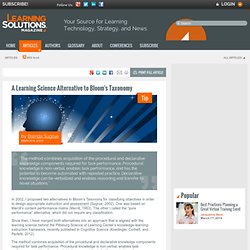
Procedural knowledge is non-verbal, enables task performance, and has the potential to become automated with repeated practice. Declarative knowledge can be verbalized and enables reasoning and transfer to novel situations.” In 2002, I proposed two alternatives to Bloom’s Taxonomy for classifying objectives in order to design appropriate instruction and assessment (Sugrue, 2002). One was based on Merrill’s content performance matrix (Merrill, 1983).
The other I called the “pure performance” alternative, which did not require any classification. A New Pedagogy is Emerging...And Online Learning is a Key Contributing Factor. In all the discussion about learning management systems, open educational resources (OERs), massive open online courses (MOOCs), and the benefits and challenges of online learning, perhaps the most important issues concern how technology is changing the way we teach and - more importantly - the way students learn.
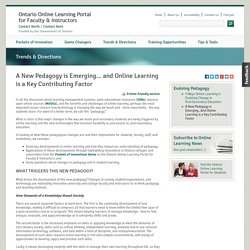
For want of a better term, we call this “pedagogy.” What is clear is that major changes in the way we teach post-secondary students are being triggered by online learning and the new technologies that increase flexibility in, and access to, post-secondary education. Research for Practitioners: How Expert Designers Design by Angela van Barneveld. “The contexts of academic and corporate designers are different—the cultures are different, and the organizational goals and objectives are different.

While prioritization of design principles for successful projects in academic versus corporate setting may differ, the actual principles are quite consistent across both.” Let’s be honest. Not everyone who is creating training or learning materials or experiences has actual training in instructional design (ID). Sometimes, by virtue of subject matter expertise, people find themselves placed in a position to develop training without the benefit of understanding instructional design.
These are instructional designers “by assignment” rather than by training. The question What do instructional designers actually do when designing competency-based learning environments? Some definitions, according to this study: The study Kirschner, Paul, Carr, Chad, and van Merrienboer, Jeroen. 2002. Mayer & Clark – 10 brilliant design rules for e-learning. Richard Mayer and Ruth Clark are among the foremost researchers in the empirical testing of media and media mix hypotheses in online learning.
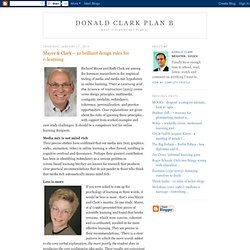
Their e-Learning and the Science of Instruction (2003) covers seven design principles; multimedia, contiguity, modality, redundancy, coherence, personalisation, and practice opportunities. Clear explanations are given about the risks of ignoring these principles - with support from worked examples and case study challenges. 21st Century Fluency Project. A Visual Primer On Learning Theory. A New Agile Model: Leaving ADDIE for SAM. Transforming learning and development. In a series of posts on the Onlignment blog that has run throughout 2012, I have endeavoured to explain how transformation can take place in workplace learning and development.
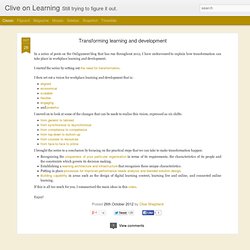
I then set out a vision for workplace learning and development that is: I moved on to look at some of the changes that can be made to realise this vision, expressed as six shifts: I brought the series to a conclusion by focusing on the practical steps that we can take to make transformation happen: The New Learning Architect. These are my live blogged notes from Clive Shepard’s presentation titled The New Learning Architect, part of the eLearning Guild’s Thought Leaders Webinar Series.

Clive’s book of the same title is available for purchase if you have a Kindle (which I don’t, so I haven’t read the book). (Update 10/16/11: Clive pointed out in the comments below that the book is also available in paperback.) Additional information and excerpts from the book are available on the Onlignment site. Any typos, mistakes, incomplete thoughts, etc. are mine, not the presenter’s. My side comments in italics. Clive saw too much “us vs. them” with people supporting traditional vs. new learning methods. The future of training « Centre for Learning & Performance Technologies. Professional Learning: The SCOPE Approach and Plan. Professional Learning is often seen as something that takes place outside the workplace.
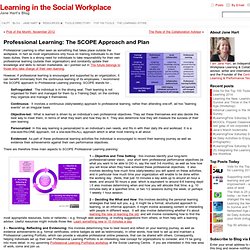
In fact as most organizations only focus on training individuals to do their basic duties, there is a strong need for individuals to take responsibility for their own professional learning (outside their organisation) and constantly update their knowledge and skills to remain marketable, as I pointed out in The future belongs to those who take charge of their own learning. However, if professional learning is encouraged and supported by an organization, it can benefit immensely from the continuous learning of its employees.
I recommend the SCOPE approach to Professional Learning planning. SCOPE stands for .. Self-regulated: The individual is in the driving seat. Continuous: It involves a continuous (daily/weekly) approach to professional learning, rather than attending one-off, ad hoc “learning events” on an irregular basis. The End of Education As We Know It. By Scott Barry Kaufman Imagine being 6 or 7 years old again, learning about addition and subtraction for the first time.
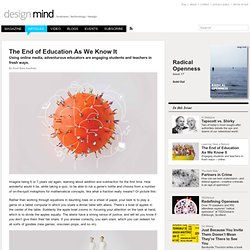
How wonderful would it be, while taking a quiz, to be able to rub a genie’s bottle and choose from a number of on-the-spot metaphors for mathematical concepts, like what a fraction really means? Or picture this: Rather than working through equations in daunting rows on a sheet of paper, your task is to play a game on a tablet computer in which you share a dinner table with aliens. There’s a bowl of apples in the center of the table. These examples may seem charming and even silly—and they’re meant to be. Traditional training structures are changing. Citrix GoToTraining has just released a paper I was commissioned to write, called What’s working and what’s not in online training.
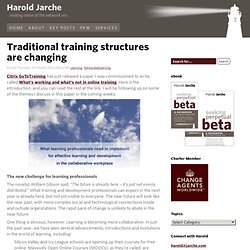
Here is the introduction, and you can read the rest at the link. The 5 Most Fundamental Strategies for Helping Your Students Learn. What do good teachers do?
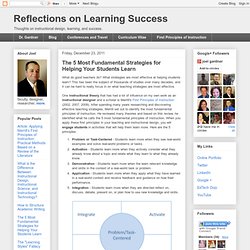
What strategies are most effective at helping students learn? This has been the subject of thousands of studies over many decades, and it can be hard to really focus in on what teaching strategies are most effective. One instructional theory that has had a lot of influence on my own work as an instructional designer and a scholar is Merrill's First Principles of Instruction (2002, 2007, 2009). After spending many years researching and discovering effective teaching strategies, Merrill set out to identify the most fundamental principles of instruction. He reviewed many theories and based on this review, he identified what he calls the 5 most fundamental principles of instruction. I've realized that the university courses and teachers that have had the greatest impact on me have used most or all of these principles. My public speaking teacher, Karla Bassett, used these principles when she taught us how to speak. Do You Agree?